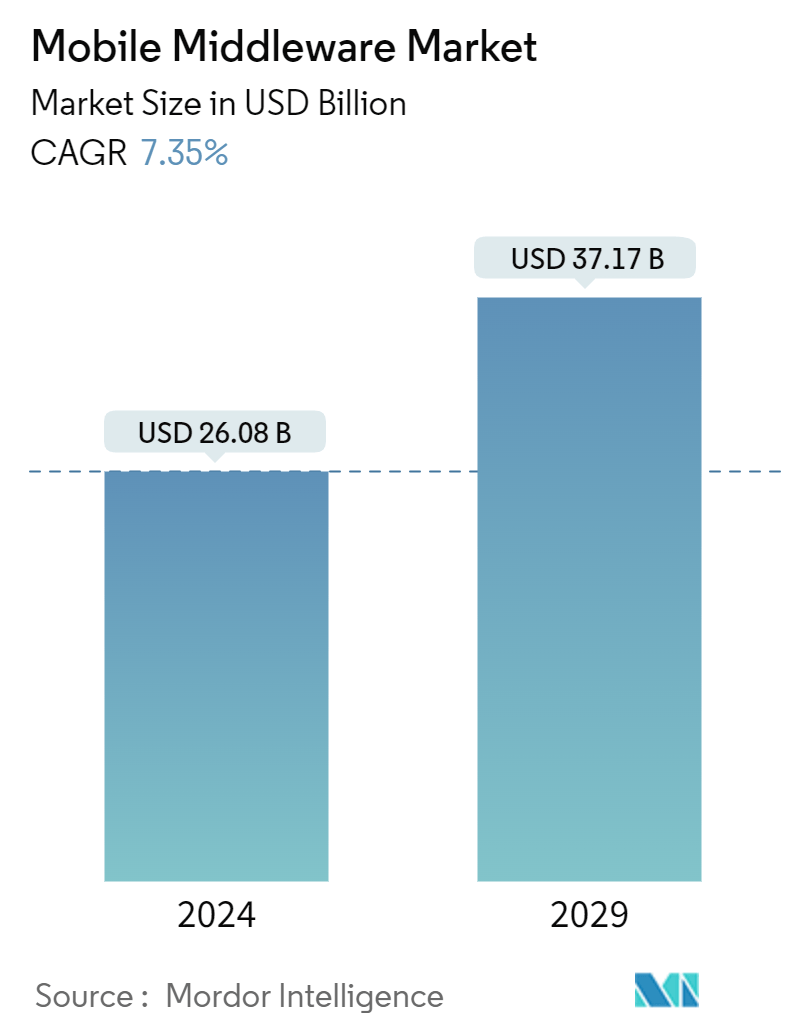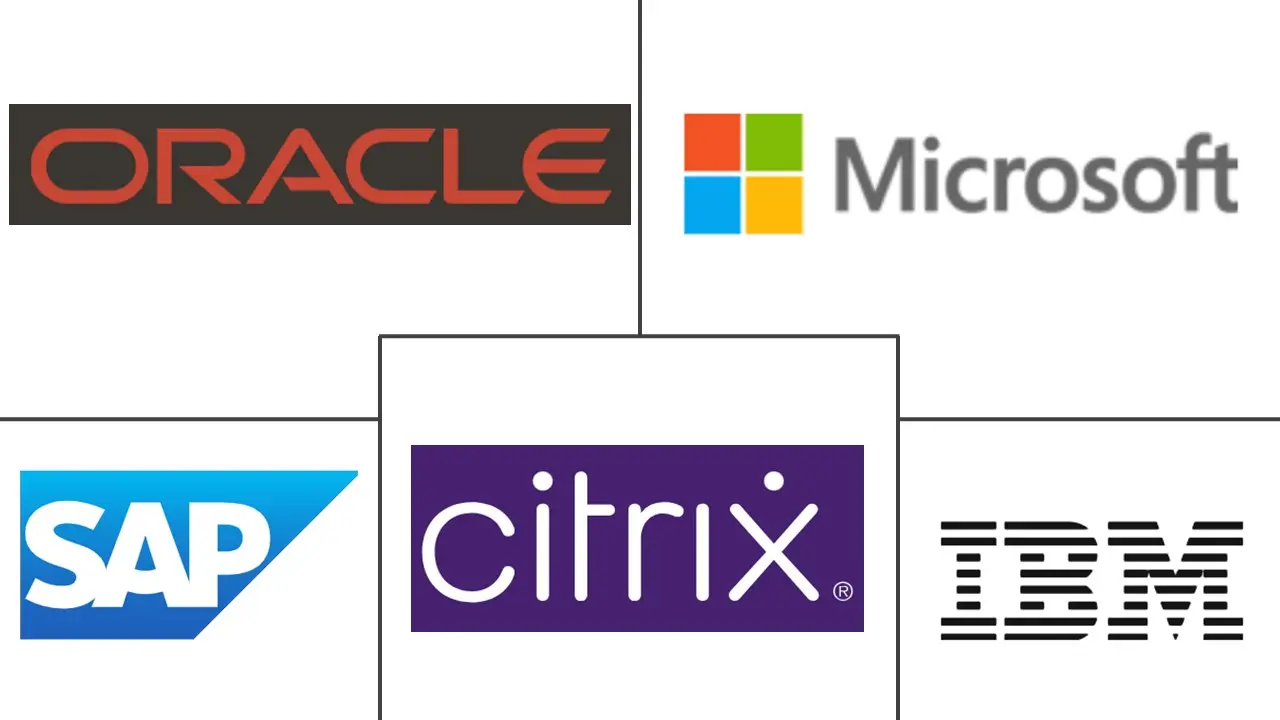Market Size of Mobile Middleware Industry

| Study Period | 2019 - 2029 |
| Market Size (2024) | USD 26.08 Billion |
| Market Size (2029) | USD 37.17 Billion |
| CAGR (2024 - 2029) | 7.35 % |
| Fastest Growing Market | Asia Pacific |
| Largest Market | North America |
Major Players
*Disclaimer: Major Players sorted in no particular order |
Mobile Middleware Market Analysis
The Mobile Middleware Market size is estimated at USD 26.08 billion in 2024, and is expected to reach USD 37.17 billion by 2029, growing at a CAGR of 7.35% during the forecast period (2024-2029).
Mobile middleware addresses specific challenges faced by mobile applications running on wireless and performs functions such as protocol optimization, data synchronization, and data compression. Many members of the global workforce are expected to adopt their own devices for work, emphasizing the need for mobile middleware solutions. The increasing need for connectivity between apps and devices has increased the demand for mobile middleware market growth.
- The primary driver for the mobile middleware market is the expansion of the BYOD concept. With businesses adopting policies to increase employee interaction, it has become essential to provide access to data from various applications due to the expansion of BYOD into industrial applications, which is expected to increase the demand in the mobile middleware market.
- Bring your device (BOYD) is the perfect model to complement the shifting work paradigm. This trend is expected to yield higher productivity, as employees will have access to efficient solutions on their preferred devices, especially smartphones, at any point in time, from any location, indirectly increasing the adoption of the BYOD trend in organizations.
- Mobile middleware is gaining rapid traction among various end-user industries and has caught the attention of many app developers for use in their app design. Middleware platforms, such as Java ME, Symbian, .NET, Android, and the iPhone, enable the industry to comply with critical requirements such as accessibility, reachability, adaptability, trustworthiness, and universality in the mobile environment.
- Concerns related to compatibility and security restrain the growth of the mobile middleware market. Mobile middleware plays a crucial role in ensuring secure communication and data transfer between mobile devices and back-end systems. The demand for robust middleware solutions has surged with the increasing reliance on mobile devices for accessing sensitive information and performing critical tasks.
- During the COVID-19 pandemic, mobile health platforms emerged to address COVID-19 challenges. Mobile computing enabled platforms to build healthcare-based solutions or to adapt the existing applications on top of these platforms. They also provide storage, processing, communication support, and middleware between the communication devices operating in the healthcare industry. In the post-pandemic era, mobile health platforms provide up-to-date and timely information to healthcare professionals, thereby propelling market growth.
Mobile Middleware Industry Segmentation
Mobile middleware is software that connects mobile applications, programs, and system apps to the operating system. The essential back-end operation is hidden, which allows the device to be used smoothly. Many mobile middleware vendors have started offering development services to deal with fast-growing mobile hardware as well as the software market.
The mobile middleware market is segmented by type (software and service), deployment (on-premise and on-cloud), end-user industry (telecommunication and ITES, retail, manufacturing, healthcare, transportation and logistic, BFSI, and other end-user industries), and geography (North America, Europe, Asia-Pacific, Latin America, and Middle East and Africa). The market sizes and forecasts are provided in terms of value (USD) for all the above segments.
| By Type | |
| Software | |
| Service |
| By Deployment | |
| On-premise | |
| On-cloud |
| By End-user Industry | |
| Telecommunication and ITES | |
| Retail | |
| Manufacturing | |
| Healthcare | |
| Transportation and Logistic | |
| BFSI | |
| Other End-user Industries |
| By Geography | |
| North America | |
| Europe | |
| Asia | |
| Australia and New Zealand | |
| Latin America | |
| Middle East and Africa |
Mobile Middleware Market Size Summary
The mobile middleware market is poised for significant growth, driven by the increasing adoption of Bring Your Own Device (BYOD) policies and the rising demand for seamless connectivity between applications and devices. Mobile middleware solutions, which address challenges such as protocol optimization, data synchronization, and data compression, are becoming essential as more employees use personal devices for work. This trend is further fueled by the expansion of industrial applications and the need for secure communication and data transfer in mobile environments. The market is also benefiting from the proliferation of cloud services, with on-cloud mobile middleware gaining traction due to its ability to offer scalability and infrastructure insights. The integration of artificial intelligence and machine learning is enhancing the efficiency and accuracy of these solutions, contributing to the market's expansion.
North America is expected to lead the global mobile middleware market, supported by the region's early adoption of cloud technologies and the presence of major technology companies. The high penetration of smartphones and mobile devices, coupled with the implementation of IoT and cloud computing, is driving the demand for mobile middleware in the region. The market is characterized by a high degree of fragmentation, with both global players and small to medium-sized enterprises competing for market share. Key players such as SAP SE, Microsoft, Citrix Systems Inc., IBM Corporation, and Oracle are actively engaging in partnerships and acquisitions to enhance their offerings and maintain a competitive edge. The ongoing developments in cloud transformations and the integration of decentralized finance solutions further underscore the dynamic nature of the mobile middleware market.
Mobile Middleware Market Size - Table of Contents
-
1. MARKET DYNAMICS
-
1.1 Market Overview
-
1.2 Introduction to Market Drivers and Restraints
-
1.3 Market Drivers
-
1.3.1 Rising Adoption of Cloud Services and Increasing Penetration of IOT Applications
-
1.3.2 Increasing Demand for Mobile Enterprise Integration
-
-
1.4 Market Restraints
-
1.4.1 Concerns Regarding Data Security and Data Breaching Globally
-
-
1.5 Industry Attractiveness - Porter's Five Forces Analysis
-
1.5.1 Threat of New Entrants
-
1.5.2 Bargaining Power of Buyers/Consumers
-
1.5.3 Bargaining Power of Suppliers
-
1.5.4 Threat of Substitute Products
-
1.5.5 Intensity of Competitive Rivalry
-
-
-
2. MARKET SEGMENTATION
-
2.1 By Type
-
2.1.1 Software
-
2.1.2 Service
-
-
2.2 By Deployment
-
2.2.1 On-premise
-
2.2.2 On-cloud
-
-
2.3 By End-user Industry
-
2.3.1 Telecommunication and ITES
-
2.3.2 Retail
-
2.3.3 Manufacturing
-
2.3.4 Healthcare
-
2.3.5 Transportation and Logistic
-
2.3.6 BFSI
-
2.3.7 Other End-user Industries
-
-
2.4 By Geography
-
2.4.1 North America
-
2.4.2 Europe
-
2.4.3 Asia
-
2.4.4 Australia and New Zealand
-
2.4.5 Latin America
-
2.4.6 Middle East and Africa
-
-
Mobile Middleware Market Size FAQs
How big is the Mobile Middleware Market?
The Mobile Middleware Market size is expected to reach USD 26.08 billion in 2024 and grow at a CAGR of 7.35% to reach USD 37.17 billion by 2029.
What is the current Mobile Middleware Market size?
In 2024, the Mobile Middleware Market size is expected to reach USD 26.08 billion.

